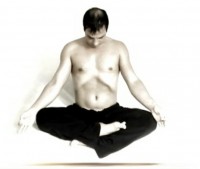Pratiloma refers to an action that is against the natural order of breath. In this yoga breathing technique the inhalations are restricted by the fingers touching the nose. This is done to create a pure and even flow of air through both nostrils and also to balance energy entering the left and right energy channels.

Instructions
Find a comfortable seated position.
Gently exhale all of the air from the lungs.

Stage 1 - Pratiloma Pranayama
Breathe in through both nostrils partially closed.
Use the hand clasp with a finger on one side and the thumb on the other. Control the flow so that it is even through both nostrils.
Exhale through both nostrils allowing the air to leave naturally without obstruction.
The purpose of this exercise is to control the air flow into the lungs so that it is balanced on both sides. This will also lengthen the breaths on the inhalations stimulating the nerves.
If conflict and struggle are present on the inhalations there may be a sense of gasping for air and fear in the mind. If this occurs stop the breathing technique and take easy breaths so that the nerves relax and the diaphragm rests. Begin Bhrāmāri Pranayama to further relax the nerves.

Stage 2 - Pratiloma Pranayama
Block the left nostril completely and inhale through a partially blocked right nostril. The traditional hand clasp can be taken up to the nose each inhalation or kept up there throughout a whole cycle of breathing which consists of inhalation and exhalation, retentions can be added in more advanced stages.
Exhale through both nostrils unobstructed.
Block the right nostril completely and inhale through a partially blocked left nostril. Control the nostrils so that the pressure and air flow is equal to the previous inhalation.
Exhale through both nostrils unobstructed.
This completes a cycle of Pratiloma Pranayama alternating nostrils on inhalation.

Stage 3 - Pratiloma Pranayama
Restrict the air flow through both nostrils and inhale through them partially blocked.
Introduce antara kumbhaka holding at the top of the breath for at least 3 seconds.
Exhale through both nostrils unobstructed.
Block the right nostril completely and inhale through a partially blocked left nostril. Control the nostrils so that the pressure and air flow is equal to the previous inhalation.
This completes a cycle of Pratiloma Pranayama with both nostrils partially blocked and a retention after inhalation.

Stage 4 - Pratiloma Pranayama
Block the left nostril completely and inhale through a partially blocked right nostril.
Introduce antara kumbhaka holding at the top of the breath for at least 3 seconds.
Exhale through both nostrils unobstructed.
Block the right nostril completely and inhale through a partially blocked left nostril. Control the nostrils so that the pressure and air flow is equal to the previous inhalation.
Once again perform antara kumbhaka holding at the top of the breath for at least 3 seconds. Gradually increase the duration of the retention each breath until a comfortable time is found.
Exhale through both nostrils unobstructed.
This completes a cycle of Pratiloma Pranayama.

Stage 5 - Pratiloma Pranayama
Restrict the air flow through both nostrils and inhale through them partially blocked.
Exhale through both nostrils unobstructed.
Introduce bahya kumbhaka holding at the bottom of the breath for at least 3 seconds. Practice lightly at first then gradually increase the time and force in the retention.
This completes a cycle of Pratiloma Pranayama with both nostrils partially blocked and a retention after exhalation.

Stage 6 - Pratiloma Pranayama
Block the left nostril completely and inhale through a partially blocked right nostril.
Exhale through both nostrils unobstructed.
Introduce bahya kumbhaka holding at the bottom of the breath for at least 3 seconds. Practice lightly at first then gradually increase the time and force in the retention.
Block the right nostril completely and inhale through a partially blocked left nostril. Control the nostrils so that the pressure and air flow is equal to the previous inhalation.
Exhale through both nostrils unobstructed.
Once again perform bahya kumbhaka holding at the bottom of the breath for at least 3 seconds.
This completes a cycle of Pratiloma Pranayama.

Stage 7 - Pratiloma Pranayama
Restrict the air flow through both nostrils and inhale through them partially blocked.
Perform antara kumbhaka holding at the top of the breath for at least 3 seconds.
Exhale through both nostrils unobstructed.
Perform bahya kumbhaka holding at the bottom of the breath for at least 3 seconds. Practice lightly at first then gradually increase the time and force of the retention.
This completes a cycle of Pratiloma Pranayama with both nostrils partially blocked and both retentions.

Stage 8 - Pratiloma Pranayama
Block the left nostril completely and inhale through a partially blocked right nostril.
Perform antara kumbhaka holding at the top of the breath for at least 3 seconds.
Exhale through both nostrils unobstructed.
Perform bahya kumbhaka holding at the bottom of the breath for at least 3 seconds. Practice lightly at first then gradually increase the time and force in the retention.
Block the right nostril completely and inhale through a partially blocked left nostril. Control the nostrils so that the pressure and air flow is equal to the previous inhalation.
Perform antara kumbhaka holding at the top of the breath for at least 3 seconds.
Exhale through both nostrils unobstructed.
Perform bahya kumbhaka holding at the bottom of the breath for at least 3 seconds.
This completes one full cycle of Pratiloma Pranayama.

Combinations of Pranayama
Begin to combine viloma pranayama with Pratiloma pranayama. This is done by interrupting the exhalations with pauses.
The pauses can also be done on the inhalations alone or in combination with the exhalations.
There is also a way of alternating the blocked nostril on the inhalation, changing the nostril that is blocked each time a pause is introduced. This produces a very balancing effect between ida and pingala the positive and negative energies.



